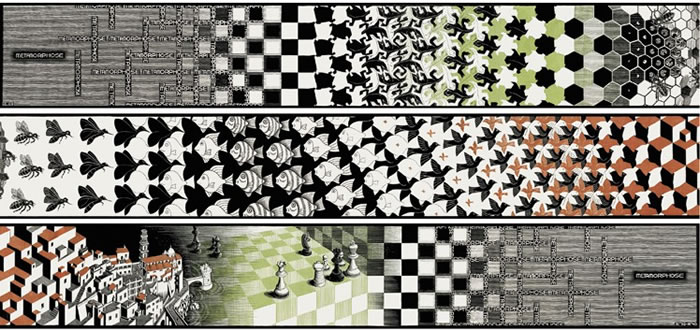Escher in Rome

Among the many artists who could not escape the charm of the Grand Tour there was also Maurits Cornelis Escher who lived in Rome in what he himself called "the best years of my life"; Here in 1926 he made his first exhibition by which began its fame in the world.
He arrived in Rome in 1925 and settled in the neighborhood of Monteverde Vecchio at the foot of the Janiculum, in a small house on Via Poerio that he had bought and where he had settled after living in Frascati for a year; from his Roman house he periodically left for trips to discover Italy. He particularly loved the Sienese lands, the towns of the Amalfi coast - where he had met and married his wife in Ravello -, of Calabria and Sicily.
In Rome his two sons were born and the family lived on the third floor of an little Art Nouveau building, while the artist had his studio in the rooftop ; in the famous lithograph of the reflecting sphere, Escher he's right in his study of the house of Monteverde.
Escher found a lively artistic environment In Rome; famous engravers, like Morbiducci, Viani and De Carolis, illustrated some magazines with their woodcuts and the director of the Dutch Cultural Institute became his friend. It was in Rome that Escher had the honor of the first major personal exhibition, at Palazzo Venezia in 1926, which was organized by the Roman Group of Engravers promoted by the art historian Federico Hermanin, the founder of the Palazzo Venezia Museum. The exhibition, which received some critical and public success, allowed Escher to be known in Italy and in Europe.
Of all the Italian period Escher has left numerous engravings, lithographs and halftone paintings that portray above all the isolated villages of the Italy he loved. There are also places in Rome that the artist has revisited with his technique based on the use of natural light and shade and perspective because Escher did not like ancient monuments, but "the nocturnal atmosphere of the city, with new public lighting and large church domes". He liked to look at the city at night and draw sitting at a cafe in the darkness with the help of a small torch hanging on his jacket; from this activity in 1934 a series of nocturnal engravings were born, seen from his eyes.
Escher's work was strongly influenced by his long stay in Italy and his artistic production up until the 1940s reflected the Italian geometric structures that were the compositional suggestions on which he would later develop the architecture of the paradox.
Escher remained in Rome until 1935, then moved to Switzerland and then to Belgium, which he left after the outbreak of World War II; in 1941 he returned to his country, Holland, where he died in 1972.
The building at no. 122 in Via Poerio where Escher lived is still in its place: a Liberty building of the twenties of the twentieth century with the ornamentation around the windows, the sober gate, the ocher painting and the windows overlooking the early twentieth century industrial Rome, between the Pyramid and the gazometer.
by M.L. ©ALL RIGHTS RESERVED (Ed 1.0 - 17/10/2019)






